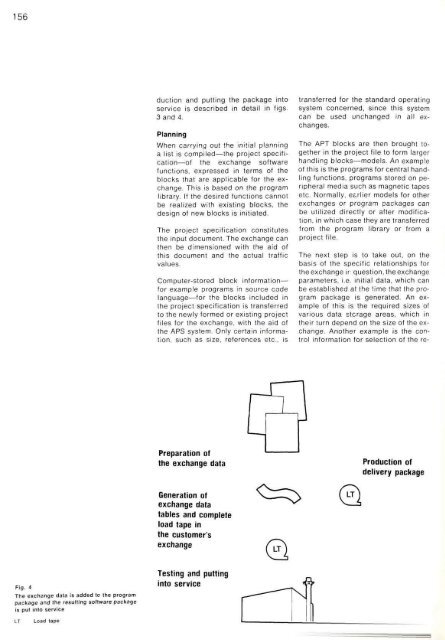geostationary telecommunications satellites electronic telephone set ...
geostationary telecommunications satellites electronic telephone set ...
geostationary telecommunications satellites electronic telephone set ...
Create successful ePaper yourself
Turn your PDF publications into a flip-book with our unique Google optimized e-Paper software.
156<br />
duction and putting the package into<br />
service is described in detail in figs.<br />
3 and 4.<br />
Planning<br />
When carrying out the initial planning<br />
a list is compiled—the project specification—of<br />
the exchange software<br />
functions, expressed in terms of the<br />
blocks that are applicable for the exchange.<br />
This is based on the program<br />
library. If the desired functions cannot<br />
be realized with existing blocks, the<br />
design of new blocks is initiated.<br />
The project specification constitutes<br />
the input document. The exchange can<br />
then be dimensioned with the aid of<br />
this document and the actual traffic<br />
values.<br />
Computer-stored block information—<br />
for example programs in source code<br />
language—for the blocks included in<br />
the project specification is transferred<br />
to the newly formed or existing project<br />
files for the exchange, with the aid of<br />
the APS system. Only certain information,<br />
such as size, references etc., is<br />
transferred for the standard operating<br />
system concerned, since this system<br />
can be used unchanged in all exchanges.<br />
The APT blocks are then brought together<br />
in the project file to form larger<br />
handling blocks—models. An example<br />
of this is the programs for central handling<br />
functions, programs stored on peripheral<br />
media such as magnetic tapes<br />
etc. Normally, earlier models for other<br />
exchanges or program packages can<br />
be utilized directly or after modification,<br />
in which case they are transferred<br />
from the program library or from a<br />
project file.<br />
The next step is to take out, on the<br />
basis of the specific relationships for<br />
theexchange ir question, theexchange<br />
parameters, i.e. initial data, which can<br />
be established at the time that the program<br />
package is generated. An example<br />
of this is the required sizes of<br />
various data storage areas, which in<br />
their turn depend on the size of the exchange.<br />
Another example is the control<br />
information for selection of the re-<br />
Preparation of<br />
the exchange data<br />
Production of<br />
delivery package<br />
Generation of<br />
exchange data<br />
tables and complete<br />
load tape in<br />
the customer's<br />
exchange<br />
Fig. 4<br />
The exchange data is added to the program<br />
package and the resulting software package<br />
is put into service<br />
Testing and putting<br />
into service<br />
LT<br />
Load tape
















